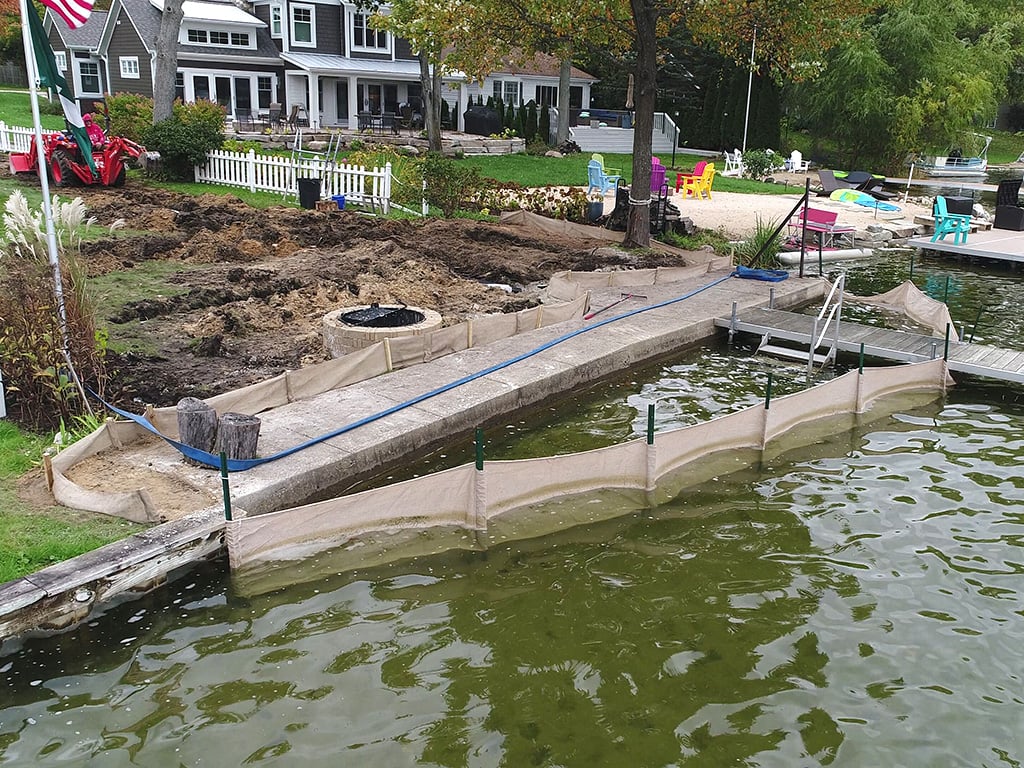SOX Specifications
Bioengineered Living Shorelines
"Repairing the Earth 1 foot at a time"
A modular open containment system made up of 2 layers of virgin pre-recycled (food grade) High Density Polyethylene (HDPE), that is constructed with a knitted pattern. The technical mesh incorporates a built-in, free flowing, structural anchoring system on all sides of the system, which is designed to be tethered into and anchored back to stable ground through a network of anchors set into a stable substrate. The living shoreline system is designed to be filled with earthen materials equal or greater than 150 microns (sand, topsoil, aeration plugs/cores, dredge spoils, and organic compost type mixtures). The light weight flexibility of the technical mesh allows the system to take any desired shape or size while the Rip Stop technology supports and promotes root vegetation. The finished surface or slope is to be shaped per the Architect/Engineers specification, prior to vegetation.
-
2 Layers of HDPE
-
Rip-Stop technology
-
Inert- meaning it does not and cannot maintain a magnetic charge so it will not negatively impact the surrounding environments
-
Built-in Structural Anchoring System
-
Anchoring Material is made of ¼” Diamond Braided Multifilament polypropylene (MFP) rope with tex core at a minimum per manufacturer’s guidance but, can be of higher gauge and strength if suggested by specifying engineer
-
Open in nature- so it can take any desired finished shape/size
-
Waterproof (Not Biodegradable)
-
Will hold earthen material equal or greater than 150 Microns
-
Will Support Root Vegetation (Sod, Seed, Plantings)
-
Break Strength Grab Method ASTM-D5034:
-
Warp = 135lbs
-
Fill = 207lbs
-
Break Elongation Grab Method ASTM-5034
-
Warp = 32.33%
-
Fill = 61.7%
-
Tear Strength Trapezoid ASTM- D5587 #1
-
Warp = 58.0 lbs
-
Fill = 70.3 lbs
-
Bursting Strength ASTM- D3786
-
284 PSI
-
Standard Availability
-
Available in Heights of 6ft, 12ft, 18ft, 24ft, etc
-
Available in Linear Lengths of 100ft or 200ft
-
Colors: Tan,Green, or Custom
-
(Fire Retardant Versions are available)
-
The existing substrate in the stable upland zone behind the deployment area will determine the most appropriate anchors.
-
Two rows of anchors
-
Anchors are set every 3 ft on both the top and bottom rows.
-
Bottom row of anchors are used to set the intended shoreline
-
Top row of anchors are for stability prevention of undermining
-
Top & bottom rows should be staggered. i.e: There should be an anchor set in the ground every 1.5ft.
-
An estimated 75 anchors per every 100 linear ft of technical mesh
-
Anchors are pounded subgrade during the fill process
-
Most commonly used Anchor: Untreated Wooden stakes:
-
Wood Stake Spec:
-
2” x 2” x 24” untreated Southern White pine. (Poplar- not recommend)
-
2 feet in length (may need to be longer depending on soil substrate and site)
-
45-degree bevel cut on the bottom of the stake (bevel should be facing away from the water and up the slope)
-
1⁄2” diameter hole drilled into the top of stake - 3” from top of the stake
-
Wood Stakes are not appropriate for: Shale, Granite, Some clay substrates, Gravel, Lateral anchoring
-
The systems’ built in structural roping channels are designed to be tethered into, cut into, and sewn at any given point.
-
Bottom structural roping channel- is to be tethered back to every bottom anchor and every other top anchor
-
Top structural roping channel- is to be tethered back to every top anchor
-
Side structural roping channels- can be used in these different ways
-
1. Connecting sections (modular)
-
2. Sewing Ends Closed using a Lock Stitch method
-
3. Tethered back to anchors laterally to enhance stability
-
Most commonly used tethering material: ¼” Diamond Braided Multifilament polypropylene (MFP) rope with tex core.
-
(MFG Code: FCH-1214 | Item Code: MFP/TEX-DB/c-1/4U-1400)
-
There are a number of factors when determining the appropriate fill material to Bioengineer a living shoreline.
-
Ultimately the site conditions will determine the appropriate fill material needed for the projects newly protected or recaptured land
-
The earthen materials (sand, topsoil, aeration plugs/cores, dredging spoils and/or organic compost type mixture) must be greater than 120 microns. (IT IS RECOMMENDED THAT ALL FILL MATERIALS BE TESTED FOR PARTICLE SIZE AND FILTRATION PROPERTIES PRIOR TO INSTALL)
-
Consider your surrounding environment, geography and topography… (Desert, Mountains, Intercoastal,Tidal or etc…)
-
It is recommend that all fill material is compacted and it is strongly recommended that water is introduced during the fill process to eliminate any voids
-
Topography of the embankment: i.e., elevations, escarpment, undermining issues, and final slope calculations = The Erosion Factor and determine the size of the system needed. i.e., 6', 12', 18', and 24'.
-
6ft system- holds an estimate of ¼ cubic yard of fill material per linear ft
-
12ft system- hold an estimate of 1/2 cubic yard of fill material per linear ft
-
18ft system- hold an estimate of 3/4 cubic yard of fill material per linear ft
-
When bioengineering any “Living” Shoreline, slope, or embankment, it is important to to consider the appropriate vegetation based on habitats and aesthetics.
-
Sod
-
Plantings
-
Seeding
Informational reports written by geotechnical engineers and environmental scientists.
ShoreSOX® erosion control system halts soil erosion and re-stabilizes shorelines and hillsides with an open-ended containment system using locally sourced material.
EvoGuard® multiuse barrier is a resilient erosion BMP technology, engineered for long-term perimeter & sediment control, and risk mitigation of mudslide & debris flow.







.png)



